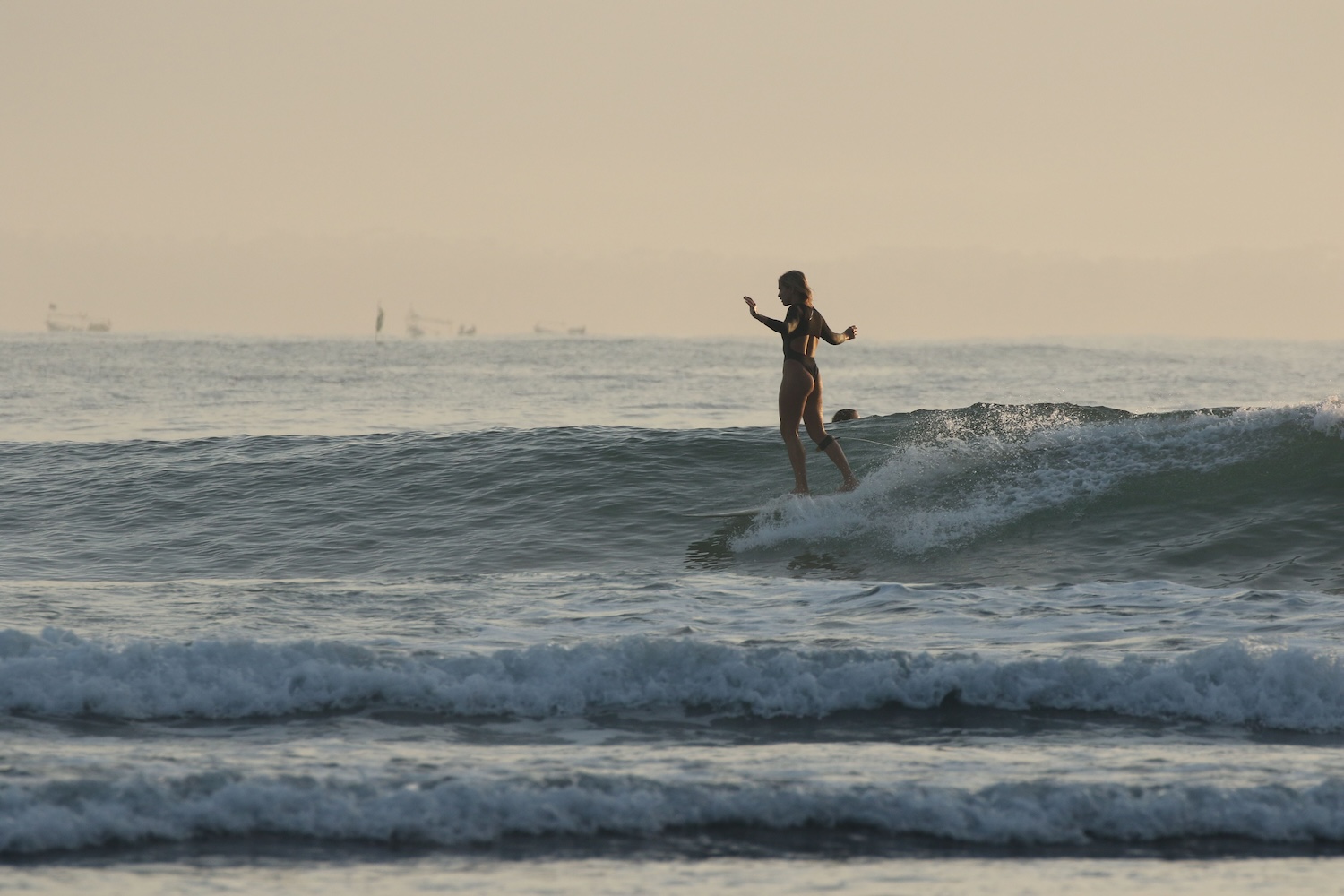
Surfers off the coast of Bali, Indonesia. (Images courtesy of the author)
This story on fighting plastic pollution in Bali is part of From the Frontline, a guest-contributed column where we hear directly from those who are impacted by climate change and environmental pollution and pushing for action. If you're interested in contributing your perspective to this column, please get in touch with us here.
Scroll idly through Instagram’s explore page and it won’t be long before you encounter an influencer’s trip to Bali, full of dream-like beaches, boasting pristine sands and crystal waters. They paint a paradisiacal vision, but if you walk down those beaches yourself, the stark reality of plastic debris intermingled with the sand and a growing tide of trash washed ashore quickly shatters the illusion so carefully cultivated for your digital consumption.
Regrettably, there are no beaches in Bali free from plastic pollution. Each year, an astounding 300,000 tons of plastic waste is generated on the island, with over 50 percent of it either openly burned or thoughtlessly discarded. Consequently, an estimated 33,000 tons of plastic waste find their way into Bali's waterways and oceans annually.
In this era of growing climate consciousness, surfers find themselves on the frontlines of confronting plastic pollution while pursuing their passion. I often have to push debris away from my board when simply paddling out to the lineup, a sadly common occurrence for surfers on the island. It falls upon us, as lovers of the ocean, to ensure its protection by embracing eco-friendly choices whenever possible. Every decision we make, even down to the suits and sunscreen we wear as we ride the waves, contributes to the collective effort of making a positive impact, no matter how small it may seem.
Plastic paradise
Three decades ago, this plastic predicament scarcely existed on the shores of Bali. Back then, everyday materials leaned toward natural biodegradability — picture palm leaves being used as food wrapping. Disposing of these materials meant returning them to the earth from where they came, completing a satisfying cycle of renewal. Almost catastrophically, this mindset purveyed into modern times.
Plastic waste washing up on our shores is hardly an issue unique to Indonesia; it’s a global concern. However, factors such as growing tourism, ingrained cultural practices and a lack of awareness about the lifecycle of plastic has led to the exponential rise in single-use plastics infiltrating the country's waterways. Alarmingly, four of Indonesia’s rivers are among the top 20 most polluted rivers worldwide, primarily due to the mismanagement of plastic waste.
In recent years, a growing number of individuals moved to take action. Brothers Sam and Gary Bencheghib made headlines in 2018 by embarking on a daring kayaking expedition down Indonesia's most polluted river, using a raft constructed entirely from plastic bottles. The brothers went on to found Sungai Watch, a nonprofit that has cleared close to 1.5 million kilograms of plastic waste and counting from Indonesia’s waters. Similarly, Balinese sisters Melati and Isabel Wijsen established Bye Bye Plastic Bags, with a focus on empowering the younger generation to take action through education and political advocacy. The organization has blossomed into one of the largest environmental nonprofits in Bali
It’s impossible to live here and remain oblivious to these pressing issues and the remarkable initiatives striving to address them. Choosing to ignore them is nothing short of an affront to our planet and future generations. Surrounded by such inspirational individuals on this island, surfers must reflect on how they too can make more environmentally conscious choices. For me, this contemplation led me on a journey to build my own brand based on bringing more environmentally-friendly options to surfers in my community.

A shift toward sustainable materials
The plastic pollution in Bali has compelled many of us to reevaluate our daily choices. It's not uncommon to see metal, paper, wooden or even fresh plant straws being used in place of plastic ones. However, there are instances when biodegradable options are simply not feasible for products that demand durability and longevity — and surf suits are a prime example.
In these circumstances, we must actively seek out alternatives. Traditional neoprene wetsuits are non-renewable and have significant, long-term detrimental effects on the earth. Fortunately, there has been a notable shift toward eco-friendly, renewable, and recycled materials as demand and awareness grows. For example, Italian fabric manufacturer Carvico launched its innovative Vita fabric in 2014. Originally designed for premium swimwear, this sustainable techno-fabric is composed of regenerated nylon made from ocean and landfill waste. When it came to selecting a high-quality recycled fabric for my own surfwear, I knew this was the perfect fit.
Given the demanding nature of the sport, suits have to not only be recycled but also deliver high performance. In a time of over-consumption, for products to be ethical they must also be long lasting, especially when they exist within one of the most polluting industries: fashion.
Moving toward slow fashion
The rise of fast-fashion giants like Shein has propelled the fashion industry into one of the planet's most egregious polluters, ranking third behind the food and construction sectors. The garment industry is so unregulated that it's hard to say just how much it’s contributing to climate change.
Driven by FOMO (a “fear of missing out”), the average consumer today buys 60 percent more than they did in 2000, further exacerbated by brands churning out double the number of clothing collections annually. This unsettling trend is perpetuated by viral videos showcasing creators unboxing gluttonously large packages of clothing, often to be worn only once or twice, with little regard for the underpaid sweatshop laborers who produced them or the inevitable fate of these hastily manufactured, low-quality garments in landfills.
For a garment to be considered ethical then, it not only must be constructed from renewable or sustainable materials, but also possess longevity and reusability. Opting for pieces that are built to last and remain stylish over time is a conscious choice to reduce one's environmental footprint, as they can be worn time and time again. While trends ebb and flow, true style endures. This principle extends beyond clothing to our surfwear.
By selecting designs that prioritize practicality and lasting appeal over fleeting trends, we can ensure their re-wearability. When designing my own pieces, I drew inspiration from timeless silhouettes that can stand the test of time. Each piece was also designed with adaptability in mind, with my proudest creations being the most versatile ones.
We can all find our own ways to make a difference
Surfers are well known for the profound connection they forge with nature while riding waves. The sport itself is intertwined with a deep love and understanding for the environment. This love is what drives me to harmonize my role as a designer and surfer and reduce my impact on the planet. Each of us must find our own way to tread lightly on the earth, make a difference in our own communities, and safeguard our oceans and environment for generations to come.

Emma Bukowski is the founder of Noserider Surf Club and a surf enthusiast. She designs functional and stylish surf suits that allow female surfers of all levels and sizes to feel beautiful and confident in the water.














